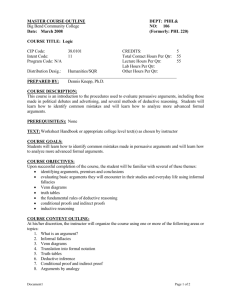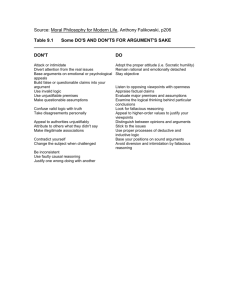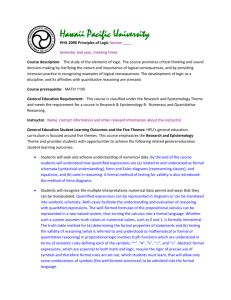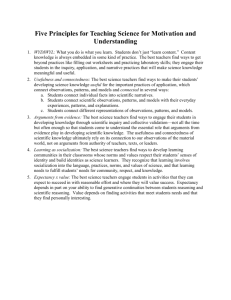PERFORMANCE TASKS
advertisement
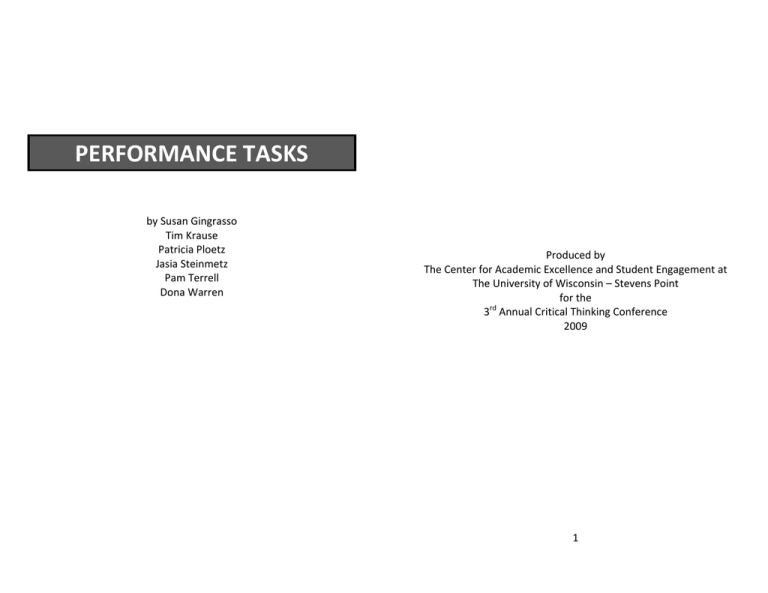
PERFORMANCE TASKS by Susan Gingrasso Tim Krause Patricia Ploetz Jasia Steinmetz Pam Terrell Dona Warren Produced by The Center for Academic Excellence and Student Engagement at The University of Wisconsin – Stevens Point for the rd 3 Annual Critical Thinking Conference 2009 1 TABLE OF CONTENTS I) Overview …………………………………………………………………….. 3 Performance Task ………………………………………………. 3 Nothing New ………………………………………………………. 3 Intrinsically Meaningful ……………………………………… 3 Not for Everything ………………………………………………. 3 II) Designing Performance Tasks …………………………………….. 4 1. Identify the Learning Outcomes ……………………… 4 2. Identify the Essential Elements of the Task …….. 4 Situation (Where? Who?) ………………….……. 4 Products / Performances (What? Why?) …. 4 Parameters (How? When?) ………………………. 5 Standards ……………………………………………….… 5 3. Build the Task ………………………..……………………….… 5 4. Create a Scoring Guide ………………………………….…. 6 III) Examples …………………………………………………………………… 7 Soda Machines in Schools …………………………………... 7 The Family Reunion ……………………………..………........ 8 Holocaust Denial ………………………………………............ 10 Entering Freshmen ……………………………………............ 12 Retirement Home Recital ………………………................ 12 IV) References / Bibliography …………………………………………. 13 2 I) OVERVIEW A performance task is a real or simulated situation that requires students to generate one or more products or performances in order to acquire mastery of identified learning outcomes (if the performance task is being administered for the purpose of instruction or formative assessment) or in order to demonstrate mastery of identified learning outcomes (if the performance task is being administered for the purpose of summative assessment). Nothing New: Although the intentional use of performance tasks in many subjects might be somewhat novel, performance tasks themselves are anything but new. Driving tests, athletic competitions, recitals, and student art exhibits are examples of performance tasks that have been used for years. Intrinsically Meaningful: By providing authentic learning experiences and assessment methods, performance tasks are intrinsically meaningful and motivating to learners. They promote collaboration, create an exciting classroom atmosphere, and teach students to continue to make practical application of academic material outside of the classroom. Furthermore, by demonstrating the “real world” importance of the targeted learning outcomes, performance tasks can bestow meaning and purpose upon more traditional learning activities and assessment methods (such as lessons, drills and exercises). Not for Everything: Performance tasks are good ways to develop and assess higher‐order thinking skills, such as the ability to gather, interpret, analyze, evaluate, and synthesize information, the ability to dissect and evaluate arguments, the ability to formulate and defend theses and hypotheses, and the ability to solve complex problems. Performance tasks might not be the best method to develop or assess other important learning outcomes, 3 including the acquisition of factual knowledge (such as the dates of the American Civil War) or the mastery of basic skills (such as the ability to factor a quadratic equation). II) DESIGNING PERFORMANCE TASKS The following is a basic outline of the process involved in designing performance tasks. 1. Identify the Learning Outcomes • What measurable learning outcomes (what knowledge or skills) will be acquired or assessed through this task? 2. Identify the Essential Elements of the Task (Who? What? Where? When? Why? How?) Situation (Where? Who?) • Context ‐ In what realistic, meaningful, and engaging context could mastery of these learning outcomes be demonstrated? Will this context be real or simulated? • Role ‐ What role could the learner assume within this context? • Challenge or Problem ‐ What challenge or problem could arise in this context? Products / Performances (What? Why?) • Products or Performances – What products or performances could learners generate to address this challenge or problem (and thereby acquire or demonstrate mastery of the learning outcomes)? • Purpose ‐ What will be the purpose of the product or performance? 4 • Audience – Who is the audience for the product or performance? Parameters (How? When?) • Resources – What resources might the learner use to generate the product or performance? Will the resource set be open or closed? Real or constructed? The resource set will often include poorly reasoned positions, irrelevant information, and other “noise” to ensure authenticity. • Individual or Collaborative – Will learners generate the products or performances individually or collaboratively? • Time Frame ‐ How long will learners be given to generate the products or performances? Standards • Criteria ‐ What criteria should the product or performance meet? Ensure that these criteria are aligned with the learning outcomes and are authentic to the situation. 3. Build the Task • Resource set – Create or assemble the resource set as necessary. • Task instructions – Compose the task instructions, including as many of the elements identified in Step 2 as possible (e.g. “You are a [role] in a [context]. [Description of challenge or problem.] Given [resources], produce [product or performance] for [audience] in order to [purpose]. Your [product or performance] must [description of standards]. You will have [time] to complete the task.”) Depending upon the nature of the performance task, you may wish to provide students with specific questions to guide their construction of the product or 5 performance (e.g. 1. Consider documents X and Y. Do they support position Z? Why or why not? 2. What hypothesis is suggested by the data in document A? How might this hypothesis be tested? 3. Given the information in documents P and Q, what is the most efficient way to solve problem R?) 4. Create a Scoring Guide • For each of the learning outcomes, identify the levels of mastery that can be demonstrated by the product or performance. • For each of the learning outcomes, identify the general characteristics of each level of mastery. Ensure that these general characteristics are aligned to the standards identified in Step 2. • For each of the learning outcomes, identify the specific characteristics of the product or performance that will be associated with each level of mastery. See Table 1. Learning Objective 1 Learning Objective 2 Learning Objective 3 Room for Improvement General characteristics Specific characteristics General characteristics Specific characteristics General characteristics Specific characteristics Good General characteristics Specific characteristics General characteristics Specific characteristics General characteristics Specific characteristics Excellent General characteristics Specific characteristics General characteristics Specific characteristics General characteristics Specific characteristics Table 1: Characteristics Describing Learning Objectives. 6 III) EXAMPLES Soda Machines in Schools Learning Outcomes: • Display correct understanding of opposing arguments • Correctly evaluate opposing arguments • Clearly articulate and adequately defend a position • Communicate effectively Performance Task: You are the advisor to the superintendent of a small school district that is currently facing a budgetary crisis. A beverage company would like to place soda machines in the lobby of the middle school. The school would get enough money from the contract to help fund the music program, which would otherwise be cut; consequently many students and parents are in favor of the vending machines. Other students and parents oppose the vending machines citing health concerns. The superintendent will be addressing this issue at a public meeting tomorrow morning and needs you to help him prepare. Given statements from students and parents on both sides, letters from the beverage company, student demographic information, and medical articles written for a lay audience, prepare a report for the superintendent that summarizes and evaluates the main arguments on both sides of the issue, recommends a course of action, and provides a defense for this course of action. In order to provide the superintendent with the best information possible, your report should correctly represent all of the relevant positions and arguments, note any difficulties with those positions and arguments, clearly recommend a course of action, and provide adequate 7 justification for that course of action. You have three hours to complete the task, and you may (of course) take breaks. Because you are the only advisor, you will be working alone. Scoring Guide: Room for Improvement Good Misrepresents Misrepresents many positions and some arguments. positions and arguments. Understanding Arguments Evaluating Arguments Incorrectly identifies Dr. Jones’s arguments as entirely hostile to soda consumption. Fails to recognize many significant problems in reasoning. Fails to distinguish between correlation and causation. Articulating and Defending a Position Fails to clearly identify the position taken or doesn’t provide any justification for the position taken. Communica‐ tion Frequent errors of style or usage. 8 Excellent Correctly represents most of the main positions and arguments. Recognizes some significant problems in reasoning. Recognizes most significant problems in reasoning. Clearly identifies the position taken and provides some justification for the position. Some errors of style or usage. Clearly identifies the position taken and Provides clear and sufficient justification for the position. Few errors of style or usage. The Family Reunion Learning Outcomes: • Clearly and charitably represent opposing viewpoints • Identify reasoning fallacies in the context of the philosophy of religion • Articulate logically sound and sensitively worded responses Performance Task: Your good friend Bill has been a very religious person his entire life but he has recently abandoned his belief in God. Bill’s family is convinced that Bill will be damned if he dies without his faith. Bill, in turn, has referred to his family members as “superstitious throwbacks to the middle ages.” Bill has always been very close to his family, so before he attends his family reunion next week, he wants to know how he can respond to his relatives in a more productive fashion. Given Bill’s letters, journal entries, and class papers, and given letters from Bill’s relatives, prepare a detailed outline that summarizes and evaluates both positions, anticipates things that Bill’s family might say to him at the reunion, and suggests some possible responses for Bill. Because Bill is very upset and because his relationship with his family hangs in the balance, Bill needs you to think very clearly on his behalf. Accordingly, you should exercise the principle of charity when representing all positions, note reasoning problems with clarity and objectivity, and provide suggestions to Bill that will further mutual understanding without escalating the conflict. Bill needs your outline by this Friday at 3:00, when his flight leaves. Because this is a personal matter, you will work alone. 9 group requested permission to bring in a speaker who denies the historical reality of the Holocaust. Given the documents provided to you (including statements from representatives from both student groups, letters from local civic and religious organizations, and the college handbook) decide whether or not the college will invite to campus the speaker who denies the Holocaust. Explain your decision and the reasoning behind it in a press release. In order to maximize clarity and understanding, your press release should lucidly support your decision by appealing to the relevant documents. It should also be relatively brief. You should have the press release ready to go by 8:00 on Monday morning. After you’ve prepared the press release, modify the message for an editorial in the student newspaper. The editorial may be longer than the press release but it should be as concise and to the point. Because the student newspaper goes to print Tuesday afternoon, you should submit the editorial by 8:00 on Tuesday morning. Finally, modify the message once more as a component of a speech that the president of the college will give at a community luncheon. The theme of the speech will be “Conflict and Controversy in Higher Education.” The president wants to address the issues raised by the events surrounding the Holocaust film series, but he doesn’t want to make this the subject of his entire address. Accordingly, he only wants two or three paragraphs from you that he can incorporate into the longer speech that he’s writing. Because the luncheon will be late Wednesday afternoon, you should submit your material to the president by 8:00 on Wednesday morning. General Scoring Guide: Room for Improvement Good Clearly and charitably represent opposing viewpoints Misrepresents many positions and arguments. Misrepresents some positions and arguments. Identify reasoning fallacies in the context of the philosophy of religion Identifies no or few fallacies. Identifies some of the fallacies. Encourages abusive and / or inflammatory responses Addresses both sides, but is problematically one‐ sided in its presentation. Articulate logically sound and sensitively put responses Excellent Correctly represents most of the main positions and arguments. Identifies most of the fallacies. Clearly articulates problems with both sides and acknowledges the strengths of both sides. Holocaust Denial Learning Outcomes: • Correctly interpret rules and policies presented in professional documents • Clearly articulate a position • Adequately defend a position • Tailor documents to purpose and audience Performance Task: You are an executive assistant to the president of a local private college. When it was publicized that a student group will be hosting a film series on the Holocaust, another student 10 11 Entering Freshmen Learning Outcomes: • Identify important information • Organize information in a logical manner • Clearly present information • Display mastery of principles of web page design Performance Task: Design a web page to provide important information for out‐ of‐town freshmen living on‐campus at your university. In order to be as useful as possible, your web page should include information that entering freshmen need to have and it should present that information in a logical and easily assessable manner. You will be working with your team members and will submit your web page, as a team, to the orientation organizing committee at the end of spring semester. Retirement Home Recital Learning Outcomes: • Use demographic information to identify audience interests • Create musical program tailored to audience interests • Display mastery of a musical instrument Performance Task: Organize and perform a recital to entertain residents at a retirement community. 12 IV) REFERENCES / BIBLIOGRAPHY • • • • • • • • • AEA 267, Curriculum, Instruction, and Assessment, “Performance Tasks,” Retrieved June 15, 2009, from http://www.aea267.k12.ia.us/cia/index.php?page=pat CLA in the Classroom, Retrieved June 15, 1009, from http://www.claintheclassroom.org/home The Department of Staff Development, in collaboration with the Division of Instruction, Prince George County Public Schools, “Process for Designing Performance Assessment Tasks,” Retrieved May 11, 2009, from http://www.pgcps.pg.k12.md.us/~elc/designsteps.html. Johnson, Robert L., James A. Penny, and Belita Gordon, Assessing Performance: Designing, Scoring, and Validating Performance Tasks, The Guilford Press, 2008. Johnson, Terri, Performance Assessment Task Library, Wisconsin Technical College System Foundation 2001. Kruglanski, Hannah, “Maryland Reading / Writing‐Language Performance Task: A Thinking Connection,” presented at the Second National Conference on Assessing Thinking: Sharing Perspective, Baltimore. 1990. Retrieved June 16, 2009, from http://www.education.umd.edu/EDMS/MARCES/mdarch/pdf/ M032047.pdf Performance Learning Systems (PLS) e‐newsletter, Performance Learning Plus, Issue #43: Performance Tasks. Retrieved May 28, 2009, from http://www.plsweb.com/resources/newsletters/enews_archiv es/43/2005/04/01/ Rogers, Spence and Shari Graham, The High Performance Toolbox: Succeeding with Performance Tasks, Projects and Assessments, Peak Learning Systems Inc., 1998. Scarborough, Jule Dee, “Performance Task and Rubric Development Assessment,” in CEET 2009 SoTL Portfolio, produced by the College of Engineering and Engineering 13 • Technology Faculty Development Program on Teaching and Learning at Northern Illinois University. Retrieved May 29, 2009, from http://www.niu.edu/CEET/p20/scholarship/vol3/C11D.pdf Wiggins, Grant and Jay McTighe, Understanding by Design, Merrill/Prentice Hall, 2005. 14


